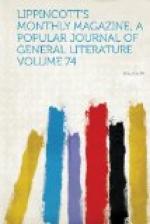a full suit of soft, pale brown contrasting with the
dark evergreens. Among these woods grow all the
wild-flowers of the long Roman spring from January
to May—flowers that I never saw in bloom
at the same time anywhere else. On banks overcanopied
by faded boughs nodded myriads of snowdrops; farther
on we held our horses’ heads well up as they
slipped, almost sitting, down the damp rocky clefts
of a gorge whose sides were purple with violets, mingling
their delicious odor, the sweetest and most sentimental
of perfumes, with the fresh, geranium-like scent of
the cyclamen, which here and there flung back its
delicate pinkish petals like one amazed: then
came acres of anemones—not our pale wind-shaken
flower, but brave asters of half a dozen superb kinds.
Up and down these passes we forced our way through
interlacing branches, which drooped too low, until
we had crossed the ridges on either side the Cremera,
and gained the valley at the head of which is Isola
Farnese, the rock-fortress supposed to occupy the
site of the citadel of Etruscan Veii. It is not
really an island, in spite of its name; only a bold
peninsula, round whose base two rivulets flow and nearly
meet. It is called a village, and so it is, with
quite a population, but the great courtyard of the
fifteenth-century castle contains them all, and the
huts, pig-pens, kennels and coops which they seem to
inhabit indiscriminately. Except where the bluff
overlooks the valley, everything is closed and shut
in by rocks and gorges, through one of which a lovely
waterfall drips from a covert of boughs and shrubbery
and wreathing ferns and creepers into a little stream,
which with musical clamor rushes at a picturesque
old mill: through another the road from the castle
passes through a narrow issue to the outer world.
And this stranded and shipwrecked fortress in the
midst of so wild a scene is all that exists to mark
where Veii stood, the powerful city which kept Rome
at bay for ten years, and fell at length by stratagem!
Its site was forgotten for nearly two thousand years,
but in this century the discovery of some tombs revealed
the secret.
[Illustration: Veii, from the
Campagna.]
[Illustration: Tivoli.]
The scenery differs entirely on different sides of
Rome. Here there is not a ruin, not a vestige,
except a few low heaps of stone-or brickwork hidden
by weeds: on the other, toward Tivoli, much of
the beauty is due to the work of man—the
stately remnants of ancient aqueduct, temple and tomb;
the tall square towers of feudal barons, round which
cluster low farm-buildings scarcely less old and solid;
the vast, gloomy grottoes of Cerbara, which look like
the underground palace of a bygone race, but which
are the tufa-quarries of classic times; the ruined
baths of Zenobia, where the rushing milky waters of
the Aquae Albulae fill the air with sulphurous fumes;
and, as a climax, the Villa of Hadrian, less a country-place




